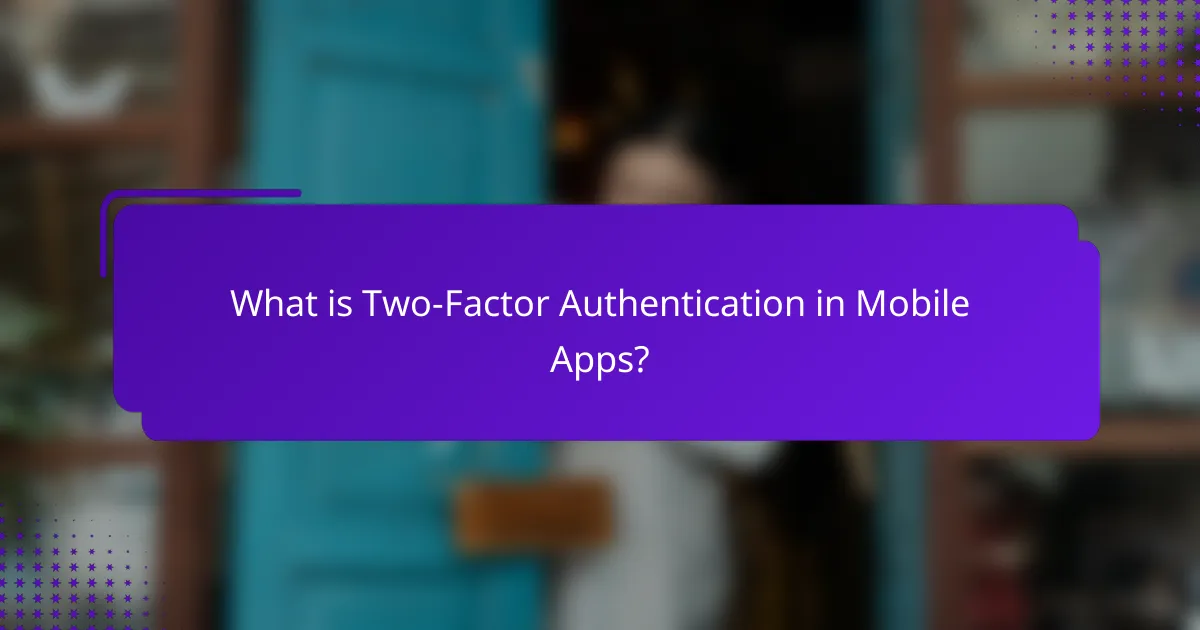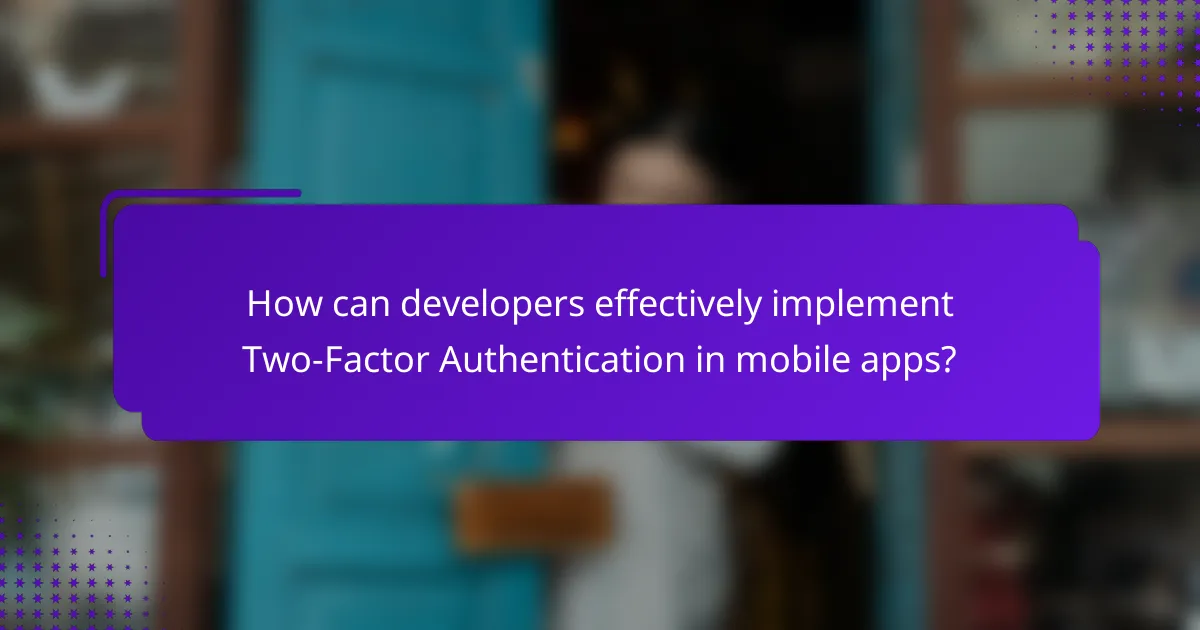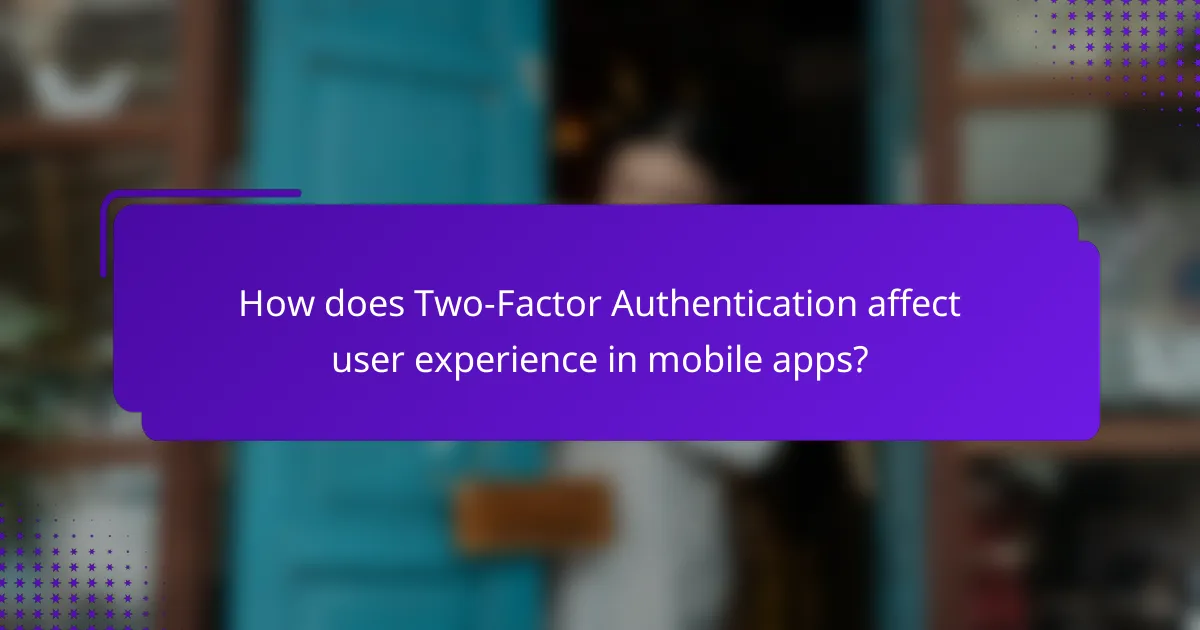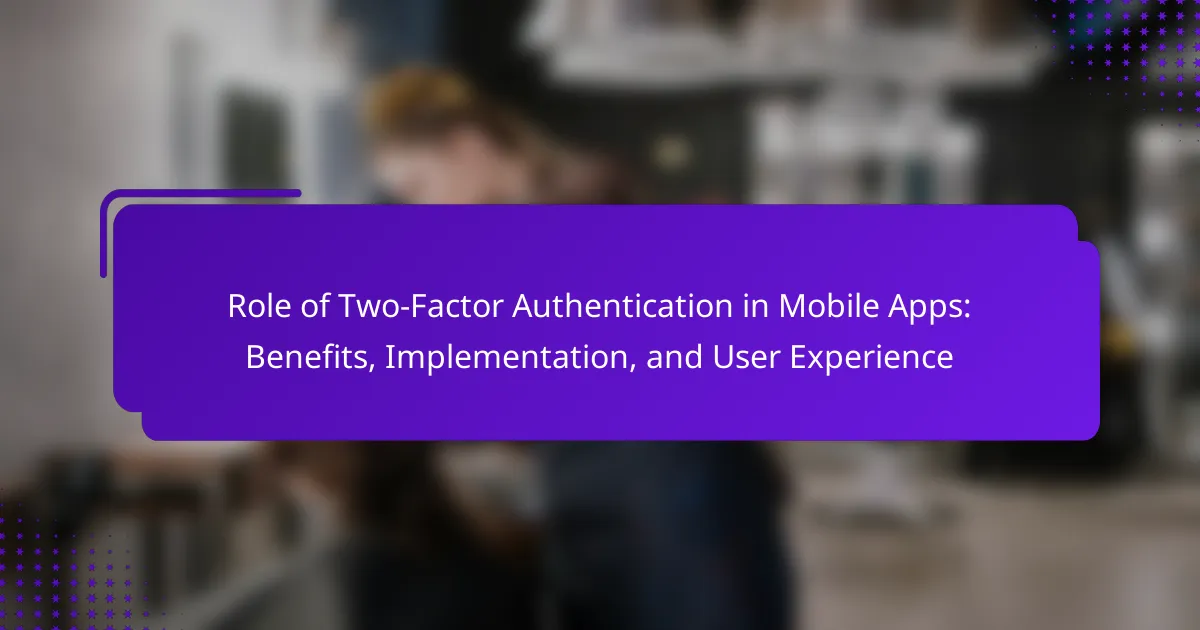Two-Factor Authentication (2FA) is a security mechanism used in mobile apps that requires users to provide two different forms of identification for account access. This article explores the benefits of 2FA, including its ability to block a significant percentage of automated attacks and enhance user trust in app security. It outlines effective implementation strategies for developers, such as selecting appropriate second-factor methods and ensuring secure storage of passwords. Additionally, the article addresses the balance between security and user experience, highlighting the potential challenges users may face during the login process and the importance of clear instructions and recovery options.

What is Two-Factor Authentication in Mobile Apps?
Two-Factor Authentication (2FA) in mobile apps is a security process that requires two distinct forms of identification from users. Typically, this involves something the user knows, like a password, and something the user possesses, such as a mobile device for receiving a verification code. This dual-layer approach significantly enhances security by making unauthorized access more difficult. According to a study by the Cybersecurity & Infrastructure Security Agency, 2FA can block up to 99.9% of automated attacks. Mobile apps implementing 2FA often utilize SMS, email, or authentication apps to deliver the second factor. This method is increasingly recommended for protecting sensitive data and user accounts.
How does Two-Factor Authentication enhance security in mobile applications?
Two-Factor Authentication (2FA) enhances security in mobile applications by requiring two forms of verification before granting access. This process adds an extra layer of protection beyond just a password. Users must provide something they know, like a password, and something they have, such as a mobile device for a verification code. This dual requirement significantly reduces the risk of unauthorized access. According to a study by Google, 2FA can block up to 100% of automated bot attacks. Furthermore, the use of 2FA decreases the likelihood of account takeovers, as attackers would need both verification methods to gain entry. Overall, 2FA is a proven strategy to strengthen security in mobile applications.
What are the key components of Two-Factor Authentication?
The key components of Two-Factor Authentication (2FA) are something you know and something you have. The first component is a password or PIN, which is a secret that the user knows. This is typically the first layer of security. The second component is a physical device or application that generates a time-sensitive code. This could be a smartphone app or a hardware token. Together, these components create a more secure authentication process. According to the Cybersecurity & Infrastructure Security Agency, 2FA significantly reduces the risk of unauthorized access.
How does the authentication process work in mobile apps?
The authentication process in mobile apps typically involves verifying a user’s identity before granting access. This process usually starts with the user entering a username and password. The app then checks these credentials against a secure database. If the credentials match, the user is authenticated.
Many mobile apps use additional security measures. These may include two-factor authentication (2FA). With 2FA, after entering the password, users receive a code via SMS or an authentication app. They must enter this code to complete the login process.
This method enhances security by requiring something the user knows (password) and something the user has (code). Statistics show that 2FA can reduce unauthorized access by over 90%. Thus, the authentication process in mobile apps is crucial for protecting user data.
What are the benefits of implementing Two-Factor Authentication in mobile apps?
Implementing Two-Factor Authentication (2FA) in mobile apps significantly enhances security. It adds an extra layer of protection beyond just a password. Users must provide a second form of verification, such as a code sent to their phone. This greatly reduces the risk of unauthorized access. According to a study by Google, 2FA can block 99.9% of automated attacks. The additional verification step deters potential hackers. It also builds user trust in the app’s security measures. Overall, 2FA improves the overall safety of sensitive data in mobile applications.
How does Two-Factor Authentication protect user data?
Two-Factor Authentication (2FA) enhances user data protection by requiring two forms of verification before granting access. This process typically involves something the user knows, like a password, and something the user has, such as a mobile device. By implementing 2FA, unauthorized access becomes significantly more difficult. Even if a password is compromised, the second factor acts as a barrier. According to a study by Google, 2FA can block 100% of automated bots and 99% of bulk phishing attacks. This statistic underscores the effectiveness of 2FA in safeguarding sensitive information.
What impact does Two-Factor Authentication have on user trust?
Two-Factor Authentication (2FA) significantly enhances user trust. By requiring a second verification step, it adds a layer of security beyond just a password. This additional measure reduces the risk of unauthorized access. Users feel more secure knowing their accounts are better protected. Studies show that implementing 2FA can decrease account compromise rates by up to 99.9%. This statistic reinforces the effectiveness of 2FA in safeguarding user information. Consequently, users are more likely to engage with services that utilize this security feature. Overall, 2FA builds confidence in the integrity of the platform.
What challenges are associated with Two-Factor Authentication in mobile apps?
Two-Factor Authentication (2FA) in mobile apps presents several challenges. User experience can be negatively impacted by the added steps in the login process. This may lead to frustration and potential abandonment of the app. Security concerns arise if users choose weak second factors, like SMS codes, which can be intercepted. Device compatibility issues may occur, as not all devices support all forms of 2FA. Furthermore, users may lose access to their second factor, such as a phone or authentication app, making account recovery difficult. There is also a risk of phishing attacks, where users are tricked into providing their 2FA codes. Lastly, educating users about the importance and functioning of 2FA can be a significant hurdle.
What common user concerns arise with Two-Factor Authentication?
Common user concerns with Two-Factor Authentication (2FA) include usability, accessibility, and security. Users often find 2FA cumbersome, as it adds extra steps to the login process. This can lead to frustration, especially if they are in a hurry. Accessibility issues arise for users who may not have reliable access to their second factor, such as a mobile device or email. Concerns about potential lockouts also exist, as losing access to the second factor can prevent account access. Additionally, some users worry about the security of their second factor. For example, SMS-based 2FA can be vulnerable to interception. Lastly, there is skepticism about whether 2FA truly enhances security, as some users believe it may not significantly deter determined attackers.
How can developers address usability issues related to Two-Factor Authentication?
Developers can address usability issues related to Two-Factor Authentication (2FA) by simplifying the user experience. They should offer multiple authentication methods, such as SMS, email, or authenticator apps. This flexibility allows users to choose their preferred method. Developers can also implement a “remember this device” feature. This feature reduces the frequency of 2FA prompts for trusted devices.
Clear instructions should be provided during the setup process. Users benefit from straightforward guidance on how to enable and use 2FA. Additionally, developers should ensure that 2FA codes are easy to enter. This can be achieved by optimizing input fields for mobile devices.
User feedback mechanisms can help identify pain points. Regular updates based on user experiences can enhance usability. Research indicates that usability improvements lead to higher adoption rates of 2FA. For instance, a study by the University of Michigan found that simplifying the authentication process significantly increased user compliance.

How can developers effectively implement Two-Factor Authentication in mobile apps?
Developers can effectively implement Two-Factor Authentication (2FA) in mobile apps by integrating a secure authentication process that requires two forms of verification. First, they should select a method for the second factor, such as SMS codes, authenticator apps, or biometric verification. Next, developers must ensure that the first factor, typically a password, is securely stored and transmitted.
Implementing a user-friendly interface for entering the second factor is crucial. Developers should provide clear instructions to guide users through the 2FA process. They must also handle exceptions, such as lost devices, with secure recovery options.
Testing the 2FA implementation is essential to identify and fix any potential vulnerabilities. Regular updates and monitoring of the authentication process can help maintain security. According to a 2021 report by Google, using 2FA can block up to 100% of automated bots and 99% of bulk phishing attacks. This highlights the effectiveness of 2FA in enhancing app security.
What are the best practices for integrating Two-Factor Authentication?
The best practices for integrating Two-Factor Authentication (2FA) include using multiple authentication methods and ensuring user education. Implementing SMS, email, or authenticator apps enhances security. It is crucial to provide clear instructions for users during the setup process. Regularly updating the authentication methods is also recommended to address emerging threats. Monitoring and logging authentication attempts can help identify suspicious activities. Additionally, offering backup codes can assist users if they lose access to their primary 2FA method. According to the Cybersecurity & Infrastructure Security Agency, adopting these practices significantly reduces the risk of unauthorized access.
Which authentication methods are most effective for mobile apps?
The most effective authentication methods for mobile apps are biometric authentication, two-factor authentication (2FA), and OAuth. Biometric authentication includes fingerprint scanning and [censured] recognition, which provide a high level of security and user convenience. Two-factor authentication adds an extra layer by requiring a second form of verification, such as a text message or authentication app code. OAuth enables secure access by allowing users to log in through trusted third-party services without sharing passwords. Studies show that apps using these methods experience significantly lower rates of unauthorized access. For instance, a report by Google indicates that 2FA can block 100% of automated bots and 99% of bulk phishing attacks.
How can developers ensure a seamless user experience during authentication?
Developers can ensure a seamless user experience during authentication by implementing user-friendly design and streamlined processes. Simplifying the login interface reduces user frustration. Offering social login options can speed up authentication. Developers should minimize the number of steps required for login. Providing clear error messages helps users understand issues quickly. Implementing session persistence allows users to stay logged in across sessions. Using biometric authentication can enhance convenience without compromising security. Research indicates that user experience improves with faster authentication methods, leading to higher user retention rates.
What technologies support Two-Factor Authentication in mobile apps?
Two-Factor Authentication (2FA) in mobile apps is supported by various technologies. These include SMS-based verification, where a code is sent to the user’s phone. Another technology is time-based one-time passwords (TOTP), which generate a unique code every 30 seconds. Push notifications are also utilized, prompting users to approve or deny login attempts. Biometric authentication, such as fingerprint or [censured] recognition, adds an additional layer of security. Hardware tokens can be used for generating codes as well. Each of these technologies enhances security by requiring multiple forms of verification.
How do SMS and email verification work as authentication methods?
SMS and email verification work as authentication methods by sending a unique code to the user’s phone or email. The user must enter this code to verify their identity. This process helps ensure that the person accessing the account is the legitimate owner. In SMS verification, a code is sent via text message to the registered mobile number. In email verification, a code is sent to the registered email address. Both methods require the user to have access to the respective device or account. This adds an extra layer of security, reducing the risk of unauthorized access. Research shows that two-factor authentication significantly decreases the likelihood of account breaches. According to a study by Google, SMS verification can prevent 76% of account hijacking attempts.
What role do authenticator apps play in Two-Factor Authentication?
Authenticator apps generate time-based one-time passwords (TOTPs) for Two-Factor Authentication (2FA). These passwords add an extra layer of security beyond just a username and password. When a user logs in, the app provides a code that changes every 30 seconds. This ensures that even if a password is compromised, unauthorized access is still prevented. Authenticator apps are widely used because they do not require an internet connection. They enhance security by relying on something the user has, in addition to something the user knows. Studies show that using 2FA significantly reduces the risk of account breaches.

How does Two-Factor Authentication affect user experience in mobile apps?
Two-Factor Authentication (2FA) enhances security but can complicate user experience in mobile apps. Users may face delays during login due to the extra step of verification. This can lead to frustration, especially if the second factor is not readily available. A study by Microsoft found that users often abandon accounts if the login process is too cumbersome. However, 2FA also increases user trust in app security. Users feel safer knowing their accounts are protected. Balancing security and convenience is crucial for optimal user experience in mobile applications.
What are the common user perceptions of Two-Factor Authentication?
Common user perceptions of Two-Factor Authentication (2FA) include increased security and inconvenience. Many users believe that 2FA enhances account protection against unauthorized access. This perception is supported by studies showing that accounts with 2FA are significantly less likely to be compromised. However, users often express frustration with the additional steps required for login. Some find the process cumbersome, especially when using multiple devices. Users may also perceive 2FA as a barrier to quick access to their accounts. Despite these concerns, many acknowledge the trade-off between security and convenience. Overall, while users recognize the importance of 2FA, they often wish for a more streamlined experience.
How can Two-Factor Authentication be designed to minimize user frustration?
Two-Factor Authentication (2FA) can be designed to minimize user frustration by ensuring simplicity and efficiency in the authentication process. Streamlined user interfaces can reduce cognitive load. Offering multiple authentication methods, such as SMS, email, or authenticator apps, increases user choice and convenience. Implementing context-aware authentication can reduce unnecessary prompts in familiar environments. Providing clear instructions during setup and login enhances user understanding. Allowing users to remember trusted devices can decrease repetitive authentication steps. Regularly updating the authentication methods based on user feedback can improve overall satisfaction. Research shows that user-friendly 2FA implementations lead to higher adoption rates and lower frustration levels.
What are the implications of Two-Factor Authentication on app accessibility?
Two-Factor Authentication (2FA) can limit app accessibility. Users may face challenges when accessing apps if they cannot receive the second factor. This includes issues like lack of mobile service or problems with authentication apps. Additionally, users with disabilities may find 2FA methods, such as SMS or app notifications, difficult to use. A study by the National Institute of Standards and Technology highlights that accessibility barriers can hinder user engagement. Thus, while 2FA enhances security, it may inadvertently restrict access for some users.
What strategies can improve user acceptance of Two-Factor Authentication?
To improve user acceptance of Two-Factor Authentication (2FA), organizations should focus on education, simplicity, and incentives. Educating users on the security benefits of 2FA increases awareness and trust. Simplicity in the setup process encourages more users to adopt it. Providing clear instructions and offering multiple authentication methods, such as SMS or authenticator apps, enhances usability. Incentives, like rewards or recognition for enabling 2FA, can motivate users to participate. Research shows that user-friendly designs and effective communication significantly boost acceptance rates of security measures.
How can education and communication enhance user understanding of Two-Factor Authentication?
Education and communication can significantly enhance user understanding of Two-Factor Authentication (2FA). By providing clear and concise information, users can grasp the importance of 2FA in securing their accounts. Educational materials can explain how 2FA adds an extra layer of security beyond just passwords. Communication strategies can include visual aids, such as infographics or videos, to illustrate the 2FA process.
Regular updates and reminders about the benefits of 2FA can reinforce its importance. Training sessions or webinars can also offer users hands-on experience with 2FA implementation. Research indicates that users who receive comprehensive training are more likely to adopt security measures like 2FA. A study by the National Institute of Standards and Technology (NIST) highlights that user education increases security awareness and compliance. Thus, effective education and communication are crucial for fostering a better understanding of Two-Factor Authentication among users.
What incentives can encourage users to adopt Two-Factor Authentication?
Incentives that can encourage users to adopt Two-Factor Authentication (2FA) include enhanced security, ease of use, and rewards. Enhanced security protects user accounts from unauthorized access. Studies show that 2FA can block 99.9% of automated attacks. Ease of use can be improved with user-friendly authentication methods, such as biometrics. Rewards, such as discounts or additional features for enabling 2FA, can motivate users. For example, platforms like Google offer additional storage for users who activate 2FA. These incentives create a compelling reason for users to adopt 2FA for better account protection.
What are the future trends in Two-Factor Authentication for mobile apps?
Future trends in Two-Factor Authentication (2FA) for mobile apps include the rise of biometric authentication methods. Biometric options such as fingerprint and [censured] recognition are becoming more popular due to their convenience and security. Additionally, the use of push notifications for authentication is increasing. This method simplifies the user experience while maintaining security.
Another trend is the integration of machine learning to enhance security. Machine learning can analyze user behavior and detect anomalies, providing an additional layer of protection. Furthermore, there is a growing emphasis on passwordless authentication. This approach reduces reliance on traditional passwords, which are often vulnerable to attacks.
The adoption of decentralized authentication methods is also on the rise. These methods can enhance privacy and security by minimizing centralized data storage. Finally, regulatory compliance is driving improvements in 2FA. Organizations are increasingly required to implement robust authentication measures to protect user data.
These trends indicate a shift towards more user-friendly, secure, and compliant authentication methods in mobile applications.
How might emerging technologies impact Two-Factor Authentication?
Emerging technologies could significantly enhance Two-Factor Authentication (2FA) systems. Innovations in biometrics, such as [censured] recognition and fingerprint scanning, provide more secure and user-friendly alternatives. These biometric methods reduce reliance on traditional SMS or email codes, which can be intercepted. Machine learning algorithms can improve the detection of fraudulent login attempts. They analyze user behavior patterns to identify anomalies. Moreover, blockchain technology could offer decentralized verification methods, increasing data security. These advancements create a more robust authentication environment. A study by the National Institute of Standards and Technology shows that biometric systems can reduce unauthorized access by up to 99%.
What role will biometrics play in the evolution of Two-Factor Authentication?
Biometrics will play a crucial role in the evolution of Two-Factor Authentication (2FA). This technology enhances security by using unique physical traits for user verification. Common biometric methods include fingerprint scanning, [censured] recognition, and iris scanning. These methods are difficult to replicate, making unauthorized access more challenging.
According to a study by the National Institute of Standards and Technology, biometric authentication can significantly reduce fraud in digital transactions. Biometrics also streamline the user experience by eliminating the need for complex passwords. This convenience can lead to higher user adoption rates of 2FA systems.
As mobile devices increasingly incorporate biometric sensors, the integration of biometrics into 2FA will likely become standard practice. This shift will enhance security while making the authentication process more user-friendly.
What are practical tips for users to enhance security with Two-Factor Authentication?
Use strong, unique passwords for each account. This prevents unauthorized access even if one password is compromised. Enable Two-Factor Authentication (2FA) on all accounts that offer it. This adds an extra layer of security beyond just passwords. Use an authenticator app instead of SMS for receiving codes. Authenticator apps are generally more secure against interception. Regularly update your recovery options, including email and phone numbers. This ensures you can regain access if needed. Be cautious of phishing attempts. Always verify the source before entering 2FA codes. Review and revoke access for any suspicious devices or applications linked to your accounts. This limits potential vulnerabilities.
Two-Factor Authentication (2FA) in mobile apps is a security mechanism that requires users to provide two forms of identification, enhancing protection against unauthorized access. This article explores the benefits of implementing 2FA, including its role in safeguarding user data and boosting trust in mobile applications. It outlines the authentication process, key components, and best practices for developers to integrate 2FA effectively while addressing common user concerns and usability challenges. Additionally, the article discusses emerging trends and technologies that will shape the future of 2FA in mobile apps, emphasizing the importance of user education and incentives for adoption.
